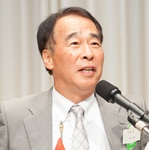Central Shinkansen Plan by Superconducting Maglev
August 5, 2015
Mr. Mamoru Uno
Central Japan Railway Company
Director, Corporate Executive Officer
�� Today, I will speak on the background and vision of the Central Shinkansen Plan with some details on the superconducting magnetically levitated linear motor car (SC Maglev).
Today, I will speak on the background and vision of the Central Shinkansen Plan with some details on the superconducting magnetically levitated linear motor car (SC Maglev).
��Central Japan Railway Company (JR Tokai) aims to transform Japan��s main transportation artery, currently shouldered solely by Tokaido Shinkansen, into a dual trunk-line system. We believe this route diversification will enhance service and security, even in the event of natural disasters, and ensure smooth connection from Tokyo to Nagoya and Osaka.
��When the Central Linear Shinkansen starts operations, travel time will be reduced to 40 minutes between Tokyo and Nagoya and 67 minutes between Tokyo and Osaka. We envision the emergence of a mega metropolis with a population of 64 million, almost half of the total population in Japan. Economic benefits to be generated by such new developments along the route were estimated in 2010 by the Council of Transport Policy to increase production value by 870 billion yen annually.
��Let me touch upon the background of the Central Shinkansen Plan, implemented in accordance with the Nationwide Shinkansen Railway Development Act. Tokaido Shinkansen started operations over 50 years ago in 1964 and brought revolutionary changes to the country, which enhanced the plan to construct the network of Shinkansen throughout Japan. The Development Act stipulated in 1973 that the Central Shinkansen would run between Tokyo and Osaka via the cities of Kofu, Nagoya and Nara. JR Tokai has conducted topographical and geological surveys. In 2007, it was determined that JR Tokai would finance the entire cost of construction between Tokyo and Nagoya. After extensive deliberations over a few years by the Council of Transport Policy on technological aspects, environmental impact, cost-effectiveness and operational capability of JR Tokai, the Minister of Land, Infrastructure, Transport and Tourism (MLIT) reached a decision in May 2011 to proceed with the construction. Preparatory work started in December 2014.
��The structure of Central Shinkansen consists of viaducts and tunnels. The route between the two terminal stations Shinagawa and Nagoya will stretch for 286 kilometers, of which 86% will be through tunnels. To ensure convenient connections with Tokaido Shinkansen and other conventional lines, the two termini will be constructed about 40 meters underground and right beneath the current Shinagawa and Nagoya Stations. Constructing massive structures beneath the railways in use will be a challenging task.
��Construction work pays utmost attention to the environment. The viaducts will be installed with soundproof walls and disaster preventive hoods. Shield tunneling method will be applied for excavation in the urban areas. Massive amount of soil generated by excavation will be reused both for the current Shinkansen construction as well as other public and private works in collaboration with municipalities and private businesses.
��Now, let me briefly share with you some technological aspects of the SC Maglev. JR Tokai has developed this unique and revolutionary technology, utilizing the on-board superconducting magnets, to achieve maximum speed of 500 kilometers per hour. SC Maglev vehicles run levitated and centered in the guideway (corresponding to the rail tracks of conventional railways) by using electromagnetic forces acting between superconducting magnets on the vehicles and reaction coils on the guideway sidewalls. Its multiple backup brakes ensure safety, even in cases of power failure or troubles at power substations, which decelerate the vehicle and automatically switch to wheels travelling for safe stoppage. The guideway sidewalls prevent the vehicle from derailing, even in the event of an earthquake. The noise and ground vibration generated by the vehicle are much smaller than the conventional Shinkansen, thanks to the electrodynamics suspension.
��As for electricity consumption, it is estimated that about 270,000 kW power will be required to provide 5 services per hour between Tokyo and Chukyo area by the time services will start in Nagoya in 2027. This is well below the level currently provided by Tokyo Electric Power Company (capacity worth 56.5 million kW), Chubu Electric Power Company (27.25 million kW) and Kansai Electric Power Company (28.75 million kW).
��Technological development for SC Maglev started as early as in 1962, preceding the operation of the Tokaido Shinkansen. A test track was constructed in Miyazaki Prefecture in 1977 where the world speed record of 517 kilometers per hour was achieved in 1979. Construction of the Yamanashi maglev test line started in 1990 and we have been advancing technological development over 20 years by conducting running tests. We achieved the world speed record of 603 kilometers per hour this April in a manned vehicle run. As many as 9,000 people have joined the test-ride event this July and August to experience the speed of 500 kilometers per hour.
��As I close my speech, let me express our determination to proceed with the construction works with careful consideration to the safety, environmental conservation as well as close collaboration with the local communities.